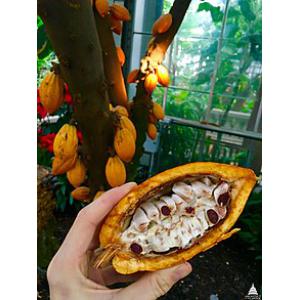From Cacao Tree to Factory
How does chocolate get from the tree to the chocolate factory?
Cacao trees usually get their start in a nursery bed where seeds from high yielding trees are planted in fiber baskets or plastic bags. The seedlings grow so fast that in a few months they are ready for transplanting.
Cocoa beans are the product of the cacao tree. The cacao tree is strictly a tropical plant thriving only in hot, rainy climates. Its cultivation is confined to the lands not more than 20 degrees north of south of the equator – like Peru, Ecuador, Nigeria, and Brazil.
The First Fruit

With pruning and careful cultivation, the trees of most strains will begin bearing fruit in the fifth year.
If you strip off the rippled outer layer of the palm-sized fruits, you will find chunks of the fibrous white pulp inside – the fruit of the cacao tree. It is mild tasting, with a subtle bittersweet chocolate flavor. Embedded in the pulp are dark, purple seeds that, after being dried and processed, are known as the famous “chocolate beans.”
Handling the Harvest
The job of picking ripe cacao pods is not an easy one. The tree is so frail and its roots are so shallow that workmen cannot risk injuring it by climbing to reach the pods on the higher branches.
The planter sends his tumbadores, or pickers, into the fields with long handled, mitten-shaped steel knives that can reach the highest pods and snip them without wounding the soft bark of the tree. Machetes are used for the pods growing within reach on the lower trunk.

The pods are collected in baskets and transported to the edge of a field where the pod breaking operation begins. One or two lengthwise blows from a well-wielded machete is usually enough to split open the woody shells. A good breaker can open 500 pods an hour.
Anywhere from 20 to 50 cream-colored beans are scooped from a typical pod and the husk and inner membrane are discarded. Dried beans from an average pod weigh less than two ounces, and approximately 400 beans are required to make one pound of chocolate.
Exposure to air quickly changes the cream-colored beans to a lavender or purple. They do not look like the finished chocolate nor do they have the well-known fragrance of chocolate at this time.
Preparing the Crop for Shipment
The cocoa beans or seeds that are removed from the pods are put into boxes or thrown on heaps and covered. Around the beans is a layer of pulp that starts to heat up and ferment. Fermentation lasts from three to nine days and serves to remove the raw bitter taste of cocoa and to develop precursors and components that are characteristic of chocolate flavor.
Fermenting is a simple “yeasting” process in which the sugars contained in the beans are converted to acid, primarily lactic acid and acetic acid.
The process generates temperatures as high as 125 degrees Fahrenheit, which kill the germ of the bean and activate existing enzymes in the beans to form compounds that produce the chocolate flavor when the beans are roasted. The result is a fully developed bean with a rich brown color, a sign that the cocoa is now ready for drying.
Left to Dry
Like any moisture-filled fruit, the beans must be dried if they are to keep. In some countries, drying is accomplished simply by laying the beans on trays or bamboo matting and leaving them to bask in the sun. Very often artificial methods are used. For example, the beans can be carried indoors and dried by hot-air pipes. Accelerated or artificial drying is quicker but produces the vastly inferior chocolate used in most mass produced products.

The finest chocolate though is produced when the drying process is done naturally by the sun for about 7 days. In this interval, farmers turn the beans frequently and use the opportunity to pick them out foreign matter and flat, broken or germinated beans. During drying, beans lose nearly all their moisture and more than half their weight.
When the beans are dried, they are prepared for shipping in 130 to 200 pound (60-90Kilo) sacks. They are seldom stored except at shipping centers, where they await inspection by buyers.
In another blog, we’ll continue following the chocolate-making process. Stay tuned!


